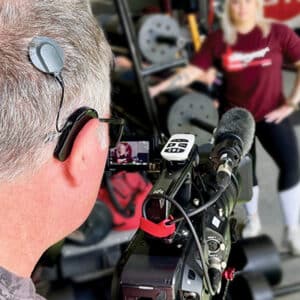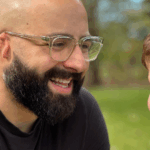MED-EL
Published Dec 08, 2021
Why a Music Lover Chose a MED-EL Cochlear Implant: John’s Story

When John from Australia started to lose his hearing, communication became more difficult and he was afraid of losing his job in the music industry. In today’s guest article the music lover talks about his process of getting a cochlear implant, how he is doing now, and why he decided to share his hearing journey on a YouTube vlog.
My name is John, I live on the Sunshine Coast in beautiful Queensland, Australia with my family. I love Harley-Davidson motorcycles, video editing & live concert sound engineering. I’ve been passionate about sound ever since I was a kid. And I’ve always had a love for music—all genres of music.
My hearing journey started many years ago: In the early 90’s I was still hearing high-frequency sounds, but by 2003 I was wearing hearing aids and suffered chronic tinnitus. Over the following years, I also developed sensitivity to unexpected and random sounds. The greatest impact of my hearing loss was on my family, and being able to communicate and stay connected, as well my ability to work in the live music production industry. It’s a job where the finer details are important, and it was distressing for me to suddenly stop hearing them. In 2019 I also made a video about my experiences and how hearing loss affected my life.
Time for the Next Step: Going for a Cochlear Implant
After over a decade of trying different products, I had almost given up on trying to find a solution that would enable me to hear properly again, until I met an audiologist, Dr Tegan Keogh, who put me onto the cochlear implant pathway. She explained to me that this solution could give me a quality of life that I didn’t have then.
After deciding to go for a cochlear implant, there was the next big decision I had to make: Which CI brand do I want to go for? The decision-making process was not at all easy. Finding information and then understanding the information was even harder. I joined a support group called CICADA, where I was able to meet and talk with implant recipients. This was probably one of the best things I did during the process. I was surrounded and supported by people who loved their CI and were happy to help me on my own journey.
I wanted to understand the technical specifications and I spent a lot of time researching the technology available from different manufacturers. For example, as a sound guy microphones are incredibly important, so I went digging into the specifications for microphone technology.
Why I Chose MED-EL
I made my decision based on the one component that I can’t easily change in the future—the implanted electrode array.
Audio processors and the features they bring will always be rapidly evolving, but the features of the MED-EL SYNCHRONY 2 implant compared to the other implant features available right now were just in a league of their own. With my professional audio background, there were numerous things that appealed to me with MED-EL’s style of engineering and their use of technology. When I was researching MED-EL and their claims about music and natural sound, and the long electrode array, it just made sense to me as somebody who understands audio. The electrode array can be selected for your individual cochlea and programmed using a CT scan generated map.
New Sounds, New Everyday Life
There are some frequencies and sounds that I had not heard for years, some sounds that I didn’t even realize were missing, like the ping of the elevator door, and the car indicators’ tick tick tick.
The time after switch-on is different for everyone, but for me I spent the first week sitting on my balcony listening to nature and birds. Being able to hear them again for the first time in decades is nothing short of pure joy.
I am also happy that I have retained my low-frequency residual hearing as I now wear my SONNET 2 EAS processor. However, I wasn’t prepared for how much energy is consumed as your body and brain adapt, as the best results will come from wearing the processors as much as possible each day. I’ve also recently been working with Rebecca, a rehabilitation manager with MED-EL, and I was surprised to realize that my speech had been deteriorating over the years. The good news is that we are already seeing improvements since switch-on day. That’s another reason to take action on your hearing loss as soon as possible.
I’ve started to do some video editing again which has contributed to my rehabilitation. I am starting to hear bass sounds really cleanly, and more recently I’m starting to hear shrills and cymbals in the music that I had forgotten existed. I know that over time and with ongoing rehabilitation the sounds of human voices and music will become more natural sounding, and as a music lover I am really looking forward to that.

Sharing “My Cochlear Journey”
Even a while before getting my cochlear implant, I decided to share my journey with others. I started an online VLOG series called “My Cochlear Journey” in the hope of bringing all the information from my own journey to others, in an easy-to-understand video series. I also wanted to bring people together, which was an important element for me as I had felt quite lonely on my journey.
I wanted to create something that covered the various stages of the journey—both pre-surgery, during surgery, and post-surgery—including the information gathering and decision-making process. Ultimately I wanted to give people a very real and relatable account, including all the highs and lows.
I’ve also shared my switch-on on the vlog:
There are currently 11 episodes, and I am now at a point in my vlog where the questions that people are asking me are creating the future episodes. For example, I am planning an upcoming episode on technical specifications explained in everyday language. It is very rewarding when someone contacts you, and you realize that people are not only watching it, but it is helping them.
My Advice for Others
If your current hearing solution is not working for you, or even if you’re told that nothing can be done for you: Get a second opinion about your hearing loss! Trust your gut feeling and don’t give up.
And once you’ve received a hearing implant, regularly check on your progress with your hearing and rehabilitation specialists.
But never forget: You’re unique, so don’t compare your journey to others!
Thank you, John!
John is also HearPeers mentor in Australia. If you live in Australia and would like to learn more about his experiences and advice, you can get in touch with John here.
MED-EL
Was this article helpful?
Thanks for your feedback.
Sign up for newsletter below for more.
Thanks for your feedback.
Please leave your message below.
Thanks for your message. We will reply as soon as possible.
Send us a message
Field is required
John Doe
Field is required
name@mail.com
Field is required
What do you think?
The content on this website is for general informational purposes only and should not be taken as medical advice. Please contact your doctor or hearing specialist to learn what type of hearing solution is suitable for your specific needs. Not all products, features, or indications shown are approved in all countries.
MED-EL


